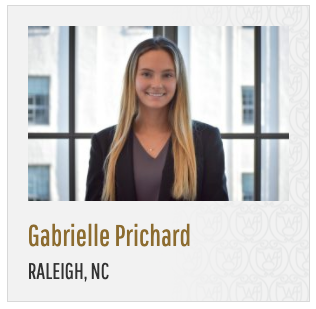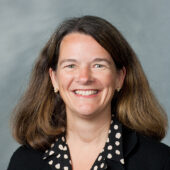Wake Forest graduates first class of liberal arts engineers
Highlights
- Established in 2017, Wake Forest’s engineering program folds the humanities and social sciences into the engineering curriculum.
- The 43 students in the first graduating class will receive their diplomas on May 16.
- 40% of the graduating class are women, about double the national average for American engineering programs. More than half the full-time engineering faculty are women.
Gabrielle Prichard will begin work as a cloud solution engineer with Oracle. Lucy Vaughn will start her career as a research and development engineer with AstraZeneca. John Hobson will become a U.S. Army engineer when he is commissioned as a second lieutenant.
They are among the 43 students in the Wake Forest University engineering program’s first graduating class who will receive their diplomas May 16.
“This is a really proud moment for not only our students, but also the faculty, the staff and everyone at the University who has helped us reach this milestone,” said Olga Pierrakos, founding chair and professor of the engineering department.
Established in 2017 at Wake Downtown in Winston-Salem’s Innovation Quarter, the engineering program is a next-door neighbor to the School of Medicine. The program is distinctive for its innovative and customizable curriculum, engagement with the community, diversity of its students and faculty, entrepreneurial mindset and emphasis on experiential learning.
“Our mission is to educate the whole engineer and humanize engineering,” Pierrakos said. “We are not a traditional engineering program.”
“ Building a program from scratch, we have been able to rethink and reimagine engineering.” Olga Pierrakos, founding chair and professor of the engineering department
The department is also precedent setting for women in engineering. Forty percent of the graduating class are women, about double the national average for American engineering programs. Nearly 60% of the engineering faculty are also women.
More than 70% of this class completed internships, 55% did undergraduate research and more than half studied abroad. Nearly two thirds have landed jobs in government and industry, while others plan to attend graduate and professional schools in engineering, medicine, law and business.
Capstone design projects
As part of the program, seniors completed yearlong capstone projects. Working in teams, they tackled 10 real-world engineering projects with real clients requiring real solutions.
Each project addressed a challenge in one of the following three areas: Renewable Energy Technologies for Sustainable Impact, Environmental Solutions for Restoring Our Ecosystems, and Biomedical Engineering Innovations for Saving Lives.
Adero Mandala’s team spent a day on site volunteering with Habitat for Humanity before beginning their project: designing a set of house plans for Habitat for Humanity of Forsyth County to use in their newest housing development.
“We created a floor plan, wall section, side elevations and a roof plan using AutoCAD that can be used by our client,” Mandala said. “It makes us feel good that we can contribute in this way. I like the idea of walking or driving by something and saying, ‘I designed that.’” His interest in structural engineering led him to an internship after his junior year with Whiting-Turner Contracting Company, and he will join the company as a project engineer.
Another capstone project team worked with a researcher at the Wake Forest Institute for Regenerative Medicine to improve the way cell seeding and scaffolding is used in tissue regeneration.
From designing and programming quadcopters to collecting atmospheric data during controlled burns to studying crash injury data, to developing coral reef monitoring systems, students also conducted a wide range of undergraduate research projects before their capstone projects.
From internships to employment
An internship at Boston Scientific helped Regan O’Donnell realize she prefers the business strategy of biomedical engineering to research and development and after graduation she will work for a healthcare consulting company focused on biotech companies.
Morgan Wallace’s passion for environmental engineering helped land her an internship with the onshore-wind engineering team at General Electric Renewable Energy and then a job with Schneider Electric in their energy management business.
“The engineering department was quick to provide dynamic customer-facing projects from the beginning of my college experience,” she said. “A few weeks into my freshman year, I was running tests to see if the Wake Downtown campus had solar capacity then presenting information to stakeholders.”
Brayan Martinez, whose favorite experience with the engineering project was building a robot car and testing it through an obstacle course, interned first as a software engineer for Red Venture, then as a technology intern for Ernst and Young where he will work after graduation.
Bradford Dhillon interned in the product design lab at NASA Goddard Space Flight Center. His classmate Maxim Belyayev interned at Collins Aerospace.
Liberal arts + engineering
“The program has definitely shaped the engineering students to be problem solvers and critical thinkers and people who can communicate well, but also have an ethical backing,” said Prichard, who got hooked on engineering once she took the entry-level course. “I have also developed the skills that are necessary to work effectively on teams.”
To get students ready for real-world engineering practice, the program brought philosophers, entrepreneurs, historians and social scientists into labs and classrooms alongside engineering professors. One engineering course module for first-year students was co-led by engineering faculty and a Wake Forest history professor showcasing the impact of engineering on society from the Renaissance to modern-day engineering practice.
With more than $700,000 in grant funding from the Kern Family Foundation and additional funding from the Mellon Foundation, Wake Forest has developed initiatives to meet the need for socially conscious engineers whose work is guided by strong ethical values and practices. Pierrakos partnered with the executive director of the Wake Forest Program for Leadership and Character to support the engineering faculty in developing and integrating learning modules focused on virtues including curiosity, courage, teamwork, resilience and grit, authenticity, practical wisdom, and empathy as part of the engineering curriculum.
One of the essential elements of our program as a whole is the infusion of the liberal arts, said assistant teaching professor of engineering Melissa Kenny. “It is why I came here [from a more traditional engineering school]. It appealed to me because we need engineers who aren’t just technical wizards.”
This humanities focus is evident in the range of majors and minors the graduating seniors have outside of engineering – everything from economics to psychology to chemistry. One student earned a minor in Middle East and South Asian Studies and studied Arabic in Morocco.
Art history and engineering major Drew Foreman said he liked stepping back “to see the art of engineering as well as the science side of engineering.” He has accepted a position with a civil and architectural engineering firm.
“You come in with different interests and don’t have to tie your boat to one dock.” Drew Foreman ('21)
An entrepreneurial mindset is also a key element of Wake Forest’s engineering program. While reverse engineering a hair dryer during a lab for her EGR 212 course, Chloe Beatty discovered a passion for learning more about hair care. She researched the properties of hair, and started creating TikToks to provide people with facts and tips to help with hair care. Beatty has more than 380k followers and over 3 million likes on her overall page. She is interning as a project planner with the Winston-Salem Department of Transportation.
Benefits of being first
The inaugural class took a chance on something new, Pierrakos said. “Their ideas, their vision, their interesting ways of connecting things allow for innovation and creativity to take place.”
One of their first tasks as first-year students was to help design a next-generation engineering lab for their new space.
“To have a voice as the program has developed has been a huge leadership opportunity,” said O’Donnell.
Associate professor of engineering Saami Yazdani shared how much student input from this first class is valued. “We really focus on teamwork. We listen to the students and, as a young department, we are agile enough to change with their needs.”
Pierrakos sees this milestone as another beginning. “The decisions that engineers make impact an entire community and impact societies. I can’t wait to see five, ten, years down the road and what they will have accomplished. They’re pioneers. They want to change the world.”



